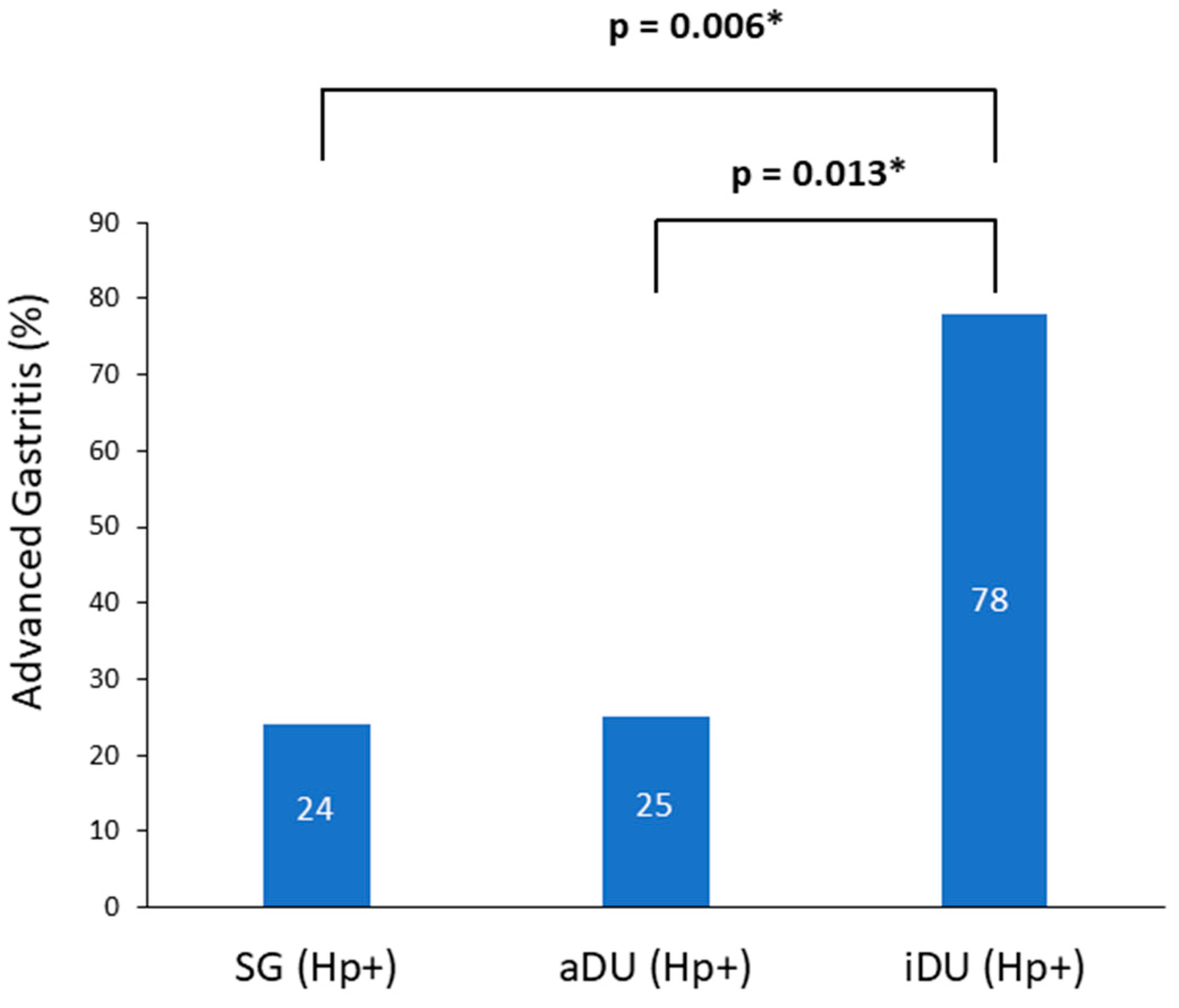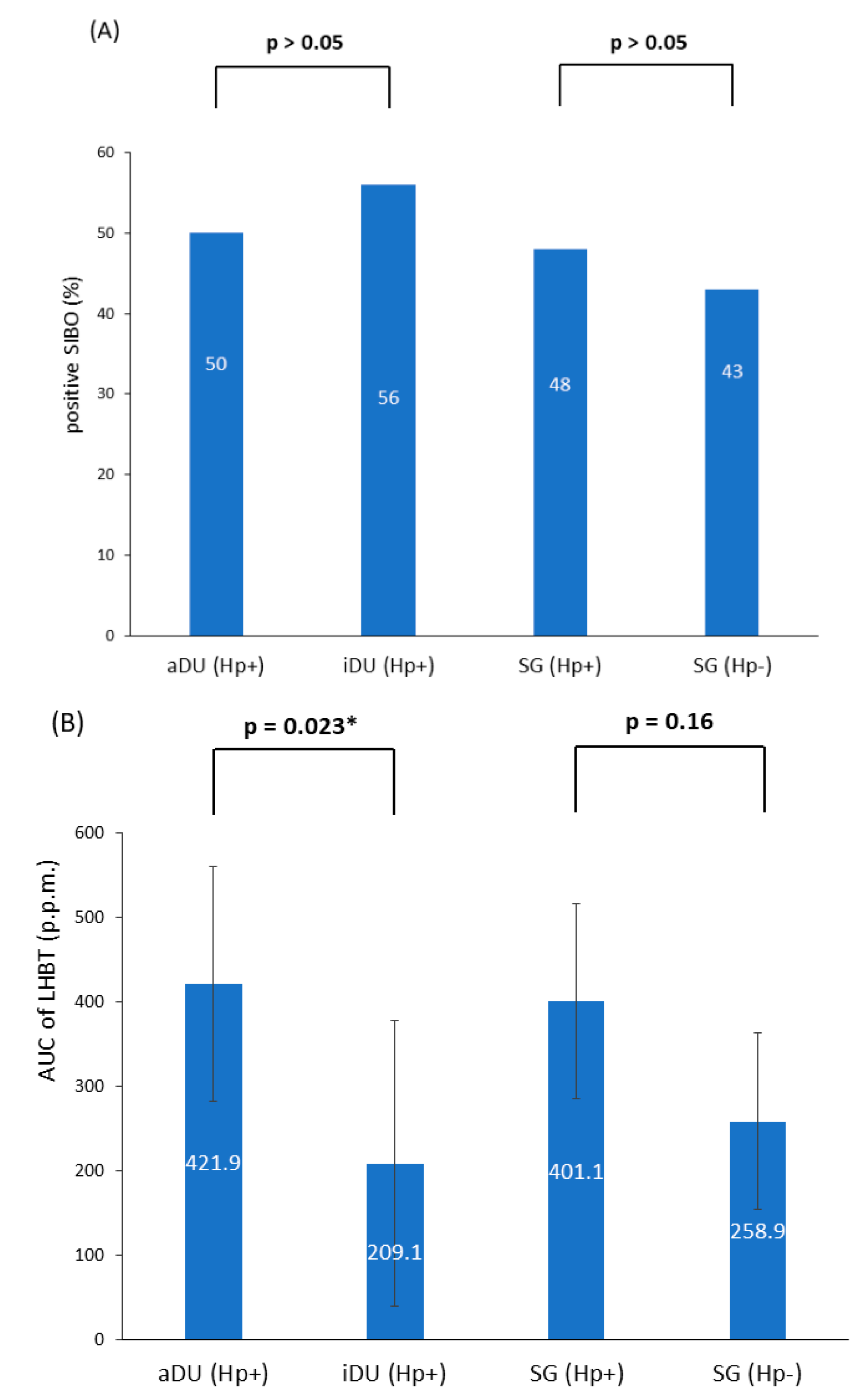Exhaled Hydrogen after Lactulose Hydrogen Breath Test in Patient with Duodenal Ulcer Disease—A Pilot Study for Helicobacter-pylori-Associated Gastroduodenal Disease
Abstract
1. Introduction
2. Materials and Methods
2.1. Patients, Inclusion, and Exclusion Criteria
2.2. Esophagogastroduodenoscopy (EGD) Examination and Histology Grading
2.3. Lactulose Hydrogen Breath Test
- An increase in hydrogen of ≥20 parts per million (p.p.m.) by 90 min;
- Two peaks during the lactulose breath test with all peaks above 20 p.p.m.
2.4. Statistical Analysis
3. Results
4. Discussion
5. Conclusions
Author Contributions
Funding
Institutional Review Board Statement
Informed Consent Statement
Data Availability Statement
Conflicts of Interest
References
- Malaty, H.M. Epidemiology of Helicobacter pylori infection. Best Pract. Res. Clin. Gastroenterol. 2007, 21, 205–214. [Google Scholar] [CrossRef] [PubMed]
- el-Omar, E.M.; Penman, I.D.; Ardill, J.E.; Chittajallu, R.S.; Howie, C.; McColl, K.E. Helicobacter pylori infection and abnormalities of acid secretion in patients with duodenal ulcer disease. Gastroenterology 1995, 109, 681–691. [Google Scholar] [CrossRef] [PubMed]
- Schulz, C.; Schütte, K.; Koch, N.; Vilchez-Vargas, R.; Wos-Oxley, M.L.; Oxley, A.P.A.; Vital, M.; Malfertheiner, P.; Pieper, D.H. The active bacterial assemblages of the upper gi tract in individuals with and without helicobacter infection. Gut 2018, 67, 216–225. [Google Scholar] [CrossRef]
- Sheh, A.; Fox, J.G. The role of the gastrointestinal microbiome in Helicobacter pylori pathogenesis. Gut Microbes 2013, 4, 505–531. [Google Scholar]
- Olson, J.W.; Maier, R.J. Molecular hydrogen as an energy source for Helicobacter pylori. Science 2002, 298, 1788–1790. [Google Scholar] [CrossRef] [PubMed]
- Maier, R.J. Availability and use of molecular hydrogen as an energy substrate for helicobacter species. Microbes Infect. 2003, 5, 1159–1163. [Google Scholar] [CrossRef]
- Wang, G.; Romero-Gallo, J.; Benoit, S.L.; Piazuelo, M.B.; Dominguez, R.L.; Morgan, D.R.; Peek, R.M., Jr.; Maier, R.J. Hydrogen metabolism in Helicobacter pylori plays a role in gastric carcinogenesis through facilitating caga translocation. mBio 2016, 7, e01022-16. [Google Scholar] [CrossRef]
- Pimentel, M.; Saad, R.J.; Long, M.D.; Rao, S.S.C. Acg clinical guideline: Small intestinal bacterial overgrowth. Am. J. Gastroenterol. 2020, 115, 165–178. [Google Scholar] [CrossRef] [PubMed]
- Saad, R.J.; Chey, W.D. Breath tests for gastrointestinal disease: The real deal or just a lot of hot air? Gastroenterology 2007, 133, 1763–1766. [Google Scholar]
- Yu, D.; Cheeseman, F.; Vanner, S. Combined oro-caecal scintigraphy and lactulose hydrogen breath testing demonstrate that breath testing detects oro-caecal transit, not small intestinal bacterial overgrowth in patients with IBS. Gut 2011, 60, 334–340. [Google Scholar] [CrossRef]
- Lin, E.C.; Massey, B.T. Scintigraphy demonstrates high rate of false-positive results from glucose breath tests for small bowel bacterial overgrowth. Clin. Gastroenterol. Hepatol. 2016, 14, 203–208. [Google Scholar] [CrossRef] [PubMed]
- Dixon, M.F.; Genta, R.M.; Yardley, J.H.; Correa, P. Classification and grading of gastritis. The updated sydney system. International workshop on the histopathology of gastritis, houston 1994. Am. J. Surg. Pathol. 1996, 20, 1161–1181. [Google Scholar] [CrossRef]
- Uemura, N.; Okamoto, S.; Yamamoto, S.; Matsumura, N.; Yamaguchi, S.; Yamakido, M.; Taniyama, K.; Sasaki, N.; Schlemper, R.J. Helicobacter pylori infection and the development of gastric cancer. N. Engl. J. Med. 2001, 345, 784–789. [Google Scholar]
- Rhodes, J.M.; Middleton, P.; Jewell, D.P. The lactulose hydrogen breath test as a diagnostic test for small-bowel bacterial overgrowth. Scand. J. Gastroenterol. 1979, 14, 333–336. [Google Scholar] [CrossRef]
- King, C.E.; Toskes, P.P. Comparison of the 1-gram [14c]xylose, 10-gram lactulose-h2, and 80-gram glucose-h2 breath tests in patients with small intestine bacterial overgrowth. Gastroenterology 1986, 91, 1447–1451. [Google Scholar]
- Rumessen, J.J.; Hamberg, O.; Gudmand-Hoyer, E. Interval sampling of end-expiratory hydrogen (h2) concentrations to quantify carbohydrate malabsorption by means of lactulose standards. Gut 1990, 31, 37–42. [Google Scholar] [CrossRef] [PubMed]
- Rezaie, A.; Heimanson, Z.; McCallum, R.; Pimentel, M. Lactulose breath testing as a predictor of response to rifaximin in patients with irritable bowel syndrome with diarrhea. Am. J. Gastroenterol. 2019, 114, 1886–1893. [Google Scholar] [CrossRef]
- Heimesaat, M.M.; Fischer, A.; Plickert, R.; Wiedemann, T.; Loddenkemper, C.; Göbel, U.B.; Bereswill, S.; Rieder, G. Helicobacter pylori induced gastric immunopathology is associated with distinct microbiota changes in the large intestines of long-term infected mongolian gerbils. PLoS ONE 2014, 9, e100362. [Google Scholar] [CrossRef] [PubMed]
- Del Zompo, F.; Ojetti, V.; Feliciani, D.; Mangiola, F.; Petruzziello, C.; Tesori, V.; Gaetani, E.; Gasbarrini, A.; Franceschi, F. Helicobacter pylori infection is associated with high methane production during lactulose breath test. Eur. Rev. Med. Pharmacol. Sci. 2016, 20, 3452–3456. [Google Scholar] [PubMed]
- Benavides-Ward, A.; Vasquez-Achaya, F.; Silva-Caso, W.; Aguilar-Luis, M.A.; Mazulis, F.; Urteaga, N.; Del Valle-Mendoza, J. Helicobacter pylori and its relationship with variations of gut microbiota in asymptomatic children between 6 and 12 years. BMC Res. Notes 2018, 11, 468. [Google Scholar]
- Queiroz, D.M.; Barbosa, A.J.; Mendes, E.N.; Rocha, G.A.; Cisalpino, E.O.; Lima, G.F., Jr.; Oliveira, C.A. Distribution of campylobacter pylori and gastritis in the stomach of patients with and without duodenal ulcer. Am. J. Gastroenterol. 1988, 83, 1368–1370. [Google Scholar] [PubMed]
- Hong, L.U.; Hsu, P.I.; David, Y.G.; Yamaoka, Y. Duodenal ulcer promoting gene of Helicobacter pylori. Gastroenterology 2005, 128, 833–848. [Google Scholar]
- Ogiwara, H.; Graham, D.Y.; Yamaoka, Y. Vaca i-region subtyping. Gastroenterology 2008, 134, 1267. [Google Scholar] [CrossRef] [PubMed]
- Argent, R.H.; Burette, A.; Miendje Deyi, V.Y.; Atherton, J.C. The presence of dupa in Helicobacter pylori is not significantly associated with duodenal ulceration in belgium, south africa, china, or north america. Clin. Infect. Dis. 2007, 45, 1204–1206. [Google Scholar] [CrossRef]
- Nguyen, L.T.; Uchida, T.; Tsukamoto, Y.; Kuroda, A.; Okimoto, T.; Kodama, M.; Murakami, K.; Fujioka, T.; Moriyama, M. Helicobacter pylori dupa gene is not associated with clinical outcomes in the japanese population. Clin. Microbiol. Infect. 2010, 16, 1264–1269. [Google Scholar]
- Yeh, Y.C.; Cheng, H.C.; Chang, W.L.; Yang, H.B.; Sheu, B.-S. Matrix metalloproteinase-3 promoter.polymorphisms but not dupa-h. Pylori correlate to duodenal ulcers in H. Pylori-infected females. BMC Microbiol. 2010, 10, 218. [Google Scholar] [CrossRef]
- Roberts-Thomson, I.C. How did the ancient bacterium, Helicobacter pylori, cause an epidemic of chronic duodenal ulceration? JGH Open 2021, 5, 636–642. [Google Scholar] [CrossRef]
- Kanno, T.; Masashi, O.; Hirotoshi, U.; Kenichi, I.; Hirohito, M.; Izumi, I.; Takao, M.; Kazuki, U.; Shotaro, E.; Mikitaka, I.; et al. Gastric acid reduction leads to an alteration in lower intestinal microflora. Biochem. Biophys. Res. Commun. 2009, 381, 666–670. [Google Scholar]
- Hsu, P.I.; Pan, C.Y.; Kao, J.Y.; Tsay, F.W.; Peng, N.J.; Kao, S.S.; Chen, Y.H.; Tsai, T.J.; Wu, D.C.; Tsai, K.W. Short-term and long-term impacts of Helicobacter pylori eradication with reverse hybrid therapy on the gut microbiota. J. Gastroenterol. Hepatol. 2019, 34, 1968–1976. [Google Scholar] [CrossRef]
- Liou, J.M.; Chen, C.C.; Chang, C.M.; Fang, Y.J.; Bair, M.J.; Chen, P.Y.; Chang, C.Y.; Hsu, Y.C.; Chen, M.J.; Chen, C.C.; et al. Long-term changes of gut microbiota, antibiotic resistance, and metabolic parameters after Helicobacter pylori eradication: A multicentre, open-label, randomised trial. Lancet Infect. Dis. 2019, 19, 1109–1120. [Google Scholar]
- Shah, A.A.-O.; Talley, N.J.; Koloski, N.A.-O.; Macdonald, G.A.; Kendall, B.J.; Shanahan, E.R.; Walker, M.A.-O.; Keely, S.; Jones, M.P.; Morrison, M.A.-O.; et al. Duodenal bacterial load as determined by quantitative polymerase chain reaction in asymptomatic controls, functional gastrointestinal disorders and inflammatory bowel disease. Aliment. Pharmacol. Ther. 2020, 52, 155–167. [Google Scholar]
- Su, Y.C.; Wang, S.Y.; Lu, S.N.; Chen, L.T.; Wu, D.C.; Chen, C.Y.; Jan, C.M.; Horowitz, M. The association between Helicobacter pylori infection and functional dyspepsia in patients with irritable bowel syndrome. AJG 2000, 95, 1900–1905. [Google Scholar]
- Kim, Y.J.; Chung, W.C.; Kim, B.W.; Kim, S.S.; Kim, J.I.; Kim, N.J.; Yoo, J.; Kim, S.H. Is Helicobacter pylori associated functional dyspepsia correlated with dysbiosis? J. Neurogastroenterol. Motil. 2017, 23, 504–516. [Google Scholar]
- Newberry, C.; Tierney, A.; Pickett-Blakely, O. Lactulose hydrogen breath test result is associated with age and gender. Biomed Res. Int. 2016, 2016, 1064029. [Google Scholar] [CrossRef]
- Ringel-Kulka, T.; Choi, C.H.; Temas, D.; Kim, A.; Maier, D.M.; Scott, K.; Galanko, J.A.; Ringel, Y. Altered colonic bacterial fermentation as a potential pathophysiological factor in irritable bowel syndrome. Am. J. Gastroenterol. 2015, 110, 1339–1346. [Google Scholar] [CrossRef]
- Enko, D.; Kriegshauser, G. Functional (13)c-urea and glucose hydrogen/methane breath tests reveal significant association of small intestinal bacterial overgrowth in individuals with active Helicobacter pylori infection. Clin. Biochem. 2017, 50, 46–49. [Google Scholar] [CrossRef]
- Sung, J.J.Y.; Coker, O.O.; Chu, E.; Szeto, C.H.; Luk, S.T.Y.; Lau, H.C.H.; Yu, J. Gastric microbes associated with gastric inflammation, atrophy and intestinal metaplasia 1 year after Helicobacter pylori eradication. Gut 2020, 69, 1572–1580. [Google Scholar]


| aDU Hp+ (n = 24) | iDU Hp+ (n = 9) | Statistics (p) | SG Hp+ (n = 29) | SG Hp− (n = 14) | Statistics (p) | |
|---|---|---|---|---|---|---|
| Gender male/female (N) | 14/10 | 5/4 | 1.0 | 12/17 | 8/6 | 0.52 a |
| Age (years, Mean ± SD) | 42.2 ± 11.9 | 52.1 ± 12.6 | 0.02 b* | 43.9 ± 9.3 | 39.4 ± 9.9 | 0.21 b |
| Advanced gastritis (N) | 6 | 7 | 0.013 a* | 7 | 0 | 0.08 a |
| Positive SIBO (%) | 50 | 56 | 0.71 a | 48 | 43 | 0.75 a |
| AUC of LHBT (p.p.m., Mean ± SE) | 421.9 ± 70.9 | 209.1 ± 86 | 0.023 b* | 401.1 ± 58.9 | 258.9 ± 53 | 0.16 b |
Disclaimer/Publisher’s Note: The statements, opinions and data contained in all publications are solely those of the individual author(s) and contributor(s) and not of MDPI and/or the editor(s). MDPI and/or the editor(s) disclaim responsibility for any injury to people or property resulting from any ideas, methods, instructions or products referred to in the content. |
© 2022 by the authors. Licensee MDPI, Basel, Switzerland. This article is an open access article distributed under the terms and conditions of the Creative Commons Attribution (CC BY) license (https://creativecommons.org/licenses/by/4.0/).
Share and Cite
Chen, Y.-H.; Chen, S.C.-J.; Wang, J.-W.; Liu, C.-S.; Wu, J.-Y.; Wu, D.-C.; Su, Y.-C. Exhaled Hydrogen after Lactulose Hydrogen Breath Test in Patient with Duodenal Ulcer Disease—A Pilot Study for Helicobacter-pylori-Associated Gastroduodenal Disease. Life 2023, 13, 45. https://doi.org/10.3390/life13010045
Chen Y-H, Chen SC-J, Wang J-W, Liu C-S, Wu J-Y, Wu D-C, Su Y-C. Exhaled Hydrogen after Lactulose Hydrogen Breath Test in Patient with Duodenal Ulcer Disease—A Pilot Study for Helicobacter-pylori-Associated Gastroduodenal Disease. Life. 2023; 13(1):45. https://doi.org/10.3390/life13010045
Chicago/Turabian StyleChen, Yi-Hsun, Sharon Chia-Ju Chen, Jiunn-Wei Wang, Chiang-Shin Liu, Jeng-Yih Wu, Deng-Chyang Wu, and Yu-Chung Su. 2023. "Exhaled Hydrogen after Lactulose Hydrogen Breath Test in Patient with Duodenal Ulcer Disease—A Pilot Study for Helicobacter-pylori-Associated Gastroduodenal Disease" Life 13, no. 1: 45. https://doi.org/10.3390/life13010045
APA StyleChen, Y.-H., Chen, S. C.-J., Wang, J.-W., Liu, C.-S., Wu, J.-Y., Wu, D.-C., & Su, Y.-C. (2023). Exhaled Hydrogen after Lactulose Hydrogen Breath Test in Patient with Duodenal Ulcer Disease—A Pilot Study for Helicobacter-pylori-Associated Gastroduodenal Disease. Life, 13(1), 45. https://doi.org/10.3390/life13010045







